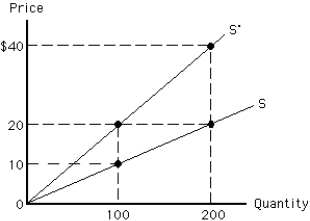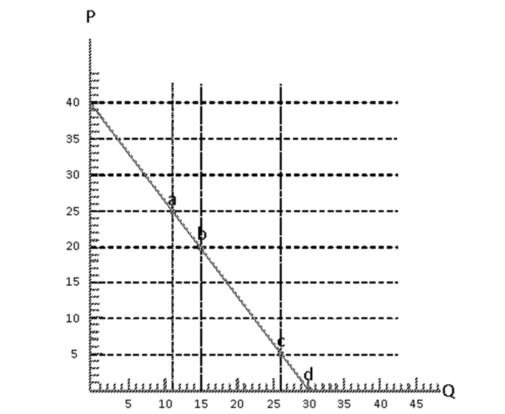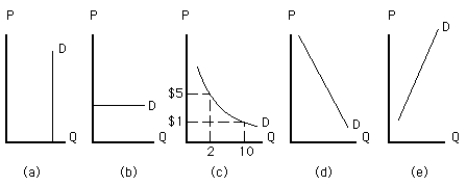A) paperback mystery stories
B) best-selling hardcover novels
C) used textbooks
D) children's books
E) leather-bound editions of Shakespeare
G) A) and E)
Correct Answer

verified
Correct Answer
verified
Multiple Choice
Exhibit 5-21  -What is the price elasticity of supply between $20 and $40 on supply curve S' in Exhibit 5-21?
-What is the price elasticity of supply between $20 and $40 on supply curve S' in Exhibit 5-21?
A) 0
B) infinity
C) 1
D) 2
E) 10
G) C) and D)
Correct Answer

verified
Correct Answer
verified
Multiple Choice
If price increases from $45 to $55, the market quantity supplied increases from 20 units per week to 30 units per week. The price elasticity of supply is
A) 1/2 = 0.5
B) 1.0
C) 11/6 = 1.8333
D) 9/4 = 2.25
E) 2.0
G) B) and E)
Correct Answer

verified
Correct Answer
verified
Multiple Choice
 -Consider Exhibit 5-28. Between points c and d, demand would be said to be
-Consider Exhibit 5-28. Between points c and d, demand would be said to be
A) perfecly price inelastic
B) price inelastic
C) perfectly price elastic
D) price elastic
E) unitary elastic
G) D) and E)
Correct Answer

verified
Correct Answer
verified
Multiple Choice
To ensure that we get the same result for price elasticity no matter which direction we move on the demand curve, we must take the average of the
A) initial price and the initial quantity demanded and the average of the new price and the new quantity demanded
B) new price and the initial quantity demanded and the average of the new quantity demanded and the initial price
C) initial price and the new price and the average of the initial quantity demanded and the new quantity demanded
D) initial price and the new price only
E) new quantity demanded and the initial quantity demanded only
G) C) and D)
Correct Answer

verified
Correct Answer
verified
Multiple Choice
Which of the following is true of U.S. farm products over the past few decades?
A) The increase in supply has been greater than the increase in demand, which has led to an increase in price.
B) The increase in supply has been less than the increase in demand, which has led to an increase in price.
C) The increase in supply has been greater than the increase in demand, which has led to a decrease in price.
D) The increase in supply has been less than the increase in demand, which has led to a decrease in price.
E) The increase in supply has been greater than the decrease in demand, which has led to an increase in price.
G) A) and B)
Correct Answer

verified
Correct Answer
verified
Multiple Choice
If an increase in price from $1.20 to $2 per unit leads to an increase in quantity supplied from 20 to 100 units,
A) demand is elastic
B) demand is inelastic
C) demand is unit elastic
D) supply is elastic
E) supply is inelastic
G) C) and D)
Correct Answer

verified
Correct Answer
verified
True/False
If income rises and the demand for a product remains unchanged, the income elasticity of demand for that product is unit elastic.
B) False
Correct Answer

verified
Correct Answer
verified
Multiple Choice
The total revenue from selling trucks is equal to
A) the price of a truck times the quantity sold
B) the change in quantity sold divided by the change in price
C) average cost times quantity produced
D) the price of a truck times the quantity produced
E) the price of a truck times the price elasticity of demand
G) A) and B)
Correct Answer

verified
Correct Answer
verified
Multiple Choice
Dusty Rags, Inc. provides janitorial services to retail stores. Dusty had been charging $10 per hour and selling 400 hours of service per week at that rate. When he raised his price to $15 per hour, his customers cut back to 300 weekly hours of service. Which of the following is true?
A) Revenue went from $4,000 per week to $4,500 per week, indicating that the demand curve for his services must have shifted to the right.
B) Revenue went from $4,000 per week to $4,500 per week, indicating that the demand for his services must be elastic.
C) Revenue went from $4,000 per week to $4,500 per week, indicating that the demand for his services must be inelastic.
D) Revenue went from $400 to $300 per week, indicating that demand must be elastic.
E) Revenue went from $10 to $15 per week, indicating that demand must be inelastic.
G) A) and E)
Correct Answer

verified
Correct Answer
verified
Multiple Choice
One group of people uses New York City subways only during rush hour to travel to and from work. Another group uses them only in midday for leisure activity. If New York City wants to increase transit fares with the smallest possible reduction in revenue, for which group should it increase the fare?
A) The rush-hour group because its demand for subway service is more elastic than that of the midday group.
B) The rush-hour group because its demand for subway service is less elastic than that of the midday group.
C) The midday group because its demand for subway service is more elastic than that of the rush-hour group.
D) The midday group because its demand for subway service is less elastic than that of the rush-hour group.
E) It doesn't matter because both groups have the same elasticity of demand.
G) B) and E)
Correct Answer

verified
Correct Answer
verified
True/False
If its value of cross-price elasticity is negative, a good must be a necessity.
B) False
Correct Answer

verified
Correct Answer
verified
Multiple Choice
A perfectly elastic demand curve is
A) a vertical straight line
B) a horizontal straight line
C) a downward-sloping straight line
D) an upward-sloping straight line
E) not a straight line
G) B) and D)
Correct Answer

verified
Correct Answer
verified
Multiple Choice
Demand is unit elastic whenever
A) price elasticity has an absolute value of 1
B) price elasticity has an absolute value greater than 1
C) price elasticity has an absolute value less than 1
D) price elasticity is negative
E) consumers always respond to a one-dollar change in price by decreasing their quantity demanded by one unit
G) B) and C)
Correct Answer

verified
Correct Answer
verified
Multiple Choice
The value of cross-price elasticity of demand between golf balls and golf clubs is
A) negative
B) positive
C) 0
D) greater than 1
E) less than 1
G) C) and D)
Correct Answer

verified
Correct Answer
verified
Multiple Choice
Along a straight-line downward-sloping demand curve, elasticity is
A) constant, but its value cannot be determined without measurement
B) constant and equal to an absolute value of one
C) greater at higher prices
D) greater at lower prices
E) greater in the middle
G) B) and D)
Correct Answer

verified
Correct Answer
verified
True/False
If the supply curve slopes upward and a $3 per unit tax on suppliers raises the profit-maximizing price by $3, demand must be perfectly inelastic.
B) False
Correct Answer

verified
Correct Answer
verified
True/False
The price elasticity of demand is equal to the slope of the demand curve.
B) False
Correct Answer

verified
Correct Answer
verified
Multiple Choice
If the sellers in the cigarette industry formed a cartel and decided to set price along a straight-line downward-sloping demand curve, which point would they choose if they wanted to gain the highest total revenue?
A) The point nearest the vertical axis, where the price is highest.
B) The point nearest the horizontal axis, where quantity demanded is greatest.
C) One of the points higher up on the demand curve, where demand is elastic.
D) One of the points lower down on the demand curve, where demand is inelastic.
E) The point of unit elasticity, in the middle of the demand curve.
G) None of the above
Correct Answer

verified
Correct Answer
verified
Multiple Choice
Exhibit 5-15  -Which of the demand curves in Exhibit 5-15 has constant elasticity everywhere?
-Which of the demand curves in Exhibit 5-15 has constant elasticity everywhere?
A) the curve in graph c only
B) the curves in graphs a and b
C) the curves in graphs a, b, and c
D) all of the curves shown
E) the curves in graphs c, d, and e
G) D) and E)
Correct Answer

verified
Correct Answer
verified
Showing 21 - 40 of 247
Related Exams